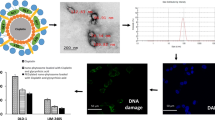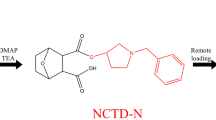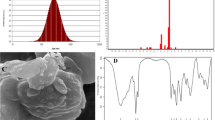Abstract
Background
In this study the formulation of parthenolide (PN), an anticancer agent extracted from a natural product, into a liposome (PN-liposome), was examined. The surface of the PN-liposome was modified using chitosan (PN-chitosome). By using real-time quantitative PCR and flow cytometry, we examined the release of PN-chitosomes, cytotoxicity, and ability to induce apoptosis in vitro.
Methods and results
According to the present study, PN-chitosomes had a size of 251 nm which is acceptable for efficient enhanced permeation and retention (EPR) performance. PN-chitosomes were confirmed to be spherical in shape and size through FESEM analysis. In terms of encapsulation efficiency, 94.5% was achieved. PN-chitosome possessed a zeta potential of 34.72 mV, which was suitable for its stability. According to the FTIR spectra of PN and PN-chitosome, PN was chemically stable due to the intermolecular interaction between the liposome and the drug. After 48 h, only 10% of the PN was released from the PN-chitosome in PBS (pH 7.4), and less than 20% was released after 144 h.
Conclusion
In a dose-dependent manner, PN-chitosome exhibited anticancer properties that were more cytotoxic against cancer cells than normal cells. Moreover, the formulation activated both the apoptosis pathway and cytotoxic genes in real-time qPCR experiments. According to the cytotoxicity and activating apoptosis of the prepared modified particle, PN-chitosome may be helpful in the treatment of cancer.








Similar content being viewed by others
Data availability
The datasets used and/or analyzed during the current study are available from the corresponding author upon reasonable request.
References
Najafi M, Majidpoor J, Toolee H, Mortezaee K (2021) The current knowledge concerning solid cancer and therapy. J Biochem Mol Toxicol 35(11):e22900
Ganesh K, Massagué J (2021) Targeting metastatic cancer. Nat Med 27(1):34–44
Dandawate PR, Subramaniam D, Jensen RA, Anant S (2016) Targeting cancer stem cells and signaling pathways by phytochemicals: novel approach for breast cancer therapy. Semin Cancer Biol 40:192–208
Karimi M, Gheybi F, Zamani P, Mashreghi M, Golmohammadzadeh S, Darban SA, Badiee A, Jaafari MR (2020) Preparation and characterization of stable nanoliposomal formulations of curcumin with high loading efficacy: in vitro and in vivo anti-tumor study. Int J Pharm 580:119211
Adel G, Javad M, Amiri MS, Mohammad M, Alireza H, Aliakbar H, Fahimeh N, Mohabat N, Mohsen Q, Yazdi ME, Vitalini S (2022) Resveratrol-mediated gold-nanoceria synthesis as green nanomedicine for phytotherapy of hepatocellular carcinoma. Front Bioscience-Landmark 27(8):1–6
Kashyap D, Tuli HS, Yerer MB, Sharma A, Sak K, Srivastava S, Pandey A, Garg VK, Sethi G, Bishayee A (2021) Natural product-based nanoformulations for cancer therapy: opportunities and challenges. Semin Cancer Biol 69:5–23
Liu YC, Kim SL, Park YR, Lee ST, Kim SW (2017) Parthenolide promotes apoptotic cell death and inhibits the migration and invasion of SW620 cells. Intestinal Res 15(2):174
Juliana C, Fernandes-Alnemri T, Wu J, Datta P, Solorzano L, Yu JW, Meng R, Quong AA, Latz E, Scott CP, Alnemri ES (2010) Anti-inflammatory compounds parthenolide and Bay 11-7082 are direct inhibitors of the inflammasome. J Biol Chem 285(13):9792–9802
Shah VO, Ferguson JE, Hunsaker LA, Deck LM, Vander Jagt DL (2010) Natural products inhibit LPS-induced activation of pro-inflammatory cytokines in peripheral blood mononuclear cells. Nat Prod Res 24(12):1177–1188
Zhang S, Ong CN, Shen HM (2004) Critical roles of intracellular thiols and calcium in parthenolide-induced apoptosis in human colorectal cancer cells. Cancer Lett 208(2):143–153
Wen J, You KR, Lee SY, Song CH, Kim DG (2002) Oxidative stress-mediated apoptosis: the anticancer effect of the sesquiterpene lactone parthenolide. J Biol Chem 277(41):38954–38964
Freund RR, Gobrecht P, Fischer D, Arndt HD (2020) Advances in chemistry and bioactivity of parthenolide. Nat Prod Rep 37(4):541–565
Carlisi D, Lauricella M, D’Anneo A, De Blasio A, Celesia A, Pratelli G, Notaro A, Calvaruso G, Giuliano M, Emanuele S (2022) Parthenolide and its soluble analogues: multitasking compounds with antitumor properties. Biomedicines 10(2):514
Chavda VP (2019) Nanobased nano drug delivery: a comprehensive review. Appl Target nano drugs delivery Syst. https://doi.org/10.1016/B978-0-12-814029-1.00004-1
Maleki MF, Jafari A, Mirhadi E, Askarizadeh A, Golichenari B, Hadizadeh F, Moghimi SM, Aryan R, Mashreghi M, Jaafari MR (2019) Endogenous stimuli-responsive linkers in nanoliposomal systems for cancer drug targeting. Int J Pharm 572:118716
Korani M, Nikoofal-Sahlabadi S, Nikpoor AR, Ghaffari S, Attar H, Mashreghi M, Jaafari MR (2020) The effect of phase transition temperature on therapeutic efficacy of liposomal bortezomib. Anti-Cancer Agents Med Chem 20(6):700–708
Mashreghi M, Faal Maleki M, Karimi M, Kalalinia F, Badiee A, Jaafari MR (2021) Improving anti-tumour efficacy of PEGylated liposomal doxorubicin by dual targeting of tumour cells and tumour endothelial cells using anti-p32 CGKRK peptide. J Drug Target 29(6):617–630
Sebaaly C, Trifan A, Sieniawska E, Greige-Gerges H (2021) Chitosan-coating effect on the characteristics of liposomes: a focus on bioactive compounds and essential oils: a review. Processes 9(3):445
Elieh-Ali-Komi D, Hamblin MR (2016) Chitin and chitosan: production and application of versatile biomedical nanomaterials. Int J Adv Res 4(3):411
Baharlouei P, Rahman A (2022) Chitin and chitosan: prospective biomedical applications in drug delivery, cancer treatment, and wound healing. Mar Drugs 20(7):460
Elsherif NI, Al-Mahallawi AM, Abdelkhalek AA, Shamma RN (2021) Investigation of the potential of nebivolol hydrochloride-loaded chitosomal systems for tissue regeneration: in vitro characterization and in vivo assessment. Pharmaceutics 13(5):700
Oransa HA, Boughdady MF, El-Sabbagh HM (2022) Novel mucoadhesive chitosomes as a platform for enhanced oral bioavailability of cinnarizine. Int J Nanomed 5641–5660
Shukla SK, Chan A, Parvathaneni V, Gupta V (2020) Metformin-loaded chitosomes for treatment of malignant pleural mesothelioma—a rare thoracic cancer. Int J Biol Macromol 160:128–141
Hamedinasab H, Rezayan AH, Mellat M, Mashreghi M, Jaafari MR (2020) Development of chitosan-coated liposome for pulmonary delivery of N-acetylcysteine. Int J Biol Macromol 156:1455–1463
Zhang H (2017) Thin-film hydration followed by extrusion method for liposome preparation. In: D’Souza G (ed) Liposomes: methods protocols. Humana Press, New York
Danaei M, Dehghankhold M, Ataei S, Hasanzadeh Davarani F, Javanmard R, Dokhani A, Khorasani S, Mozafari MR (2018) Impact of particle size and polydispersity index on the clinical applications of lipidic nanocarrier systems. Pharmaceutics 10(2):57
Refai H, Hassan D, Abdelmonem R (2017) Development and characterization of polymer-coated liposomes for vaginal delivery of sildenafil citrate. Drug Delivery 24(1):278–288
Souza TG, Ciminelli VS, Mohallem ND (2016) A comparison of TEM and DLS methods to characterize size distribution of ceramic nanoparticles. J Phys 733:012039
Srakaew V, Tachaboonyakiat W (2017) Evaluation of the active functional groups and structural rearrangement of parthenolide derivatives on their potential anticancer activity. J Mol Struct 1135:202–208
Jana U, Mohanty AK, Pal SL, Manna PK, Mohanta GP (2014) Felodipine loaded PLGA nanoparticles: preparation, physicochemical characterization and in vivo toxicity study. Nano Convergence 1(1):1–10
Wu J (2021) The enhanced permeability and retention (EPR) effect: the significance of the concept and methods to enhance its application. J Personalized Med 11(8):771
Bork PM, Schmitz ML, Kuhnt M, Escher C, Heinrich M (1997) Sesquiterpene lactone containing Mexican Indian medicinal plants and pure sesquiterpene lactones as potent inhibitors of transcription factor NF-κB. FEBS Lett 402(1):85–90
Patra JK, Das G, Fraceto LF, Campos EV, Rodriguez-Torres MD, Acosta-Torres LS, Diaz-Torres LA, Grillo R, Swamy MK, Sharma S, Habtemariam S (2018) Nano based drug delivery systems: recent developments and future prospects. J Nanobiotechnol 16(1):1–33
Lee SJ, Jung YH, Oh SY, Song EJ, Choi SH, Han HJ (2015) Vibrio vulnificus VvhA induces NF-κB-dependent mitochondrial cell death via lipid raft-mediated ROS production in intestinal epithelial cells. Cell Death Dis 6(2):e1655–e1655
Jiang L, Sheikh MS, Huang Y (2010) Decision making by p53: life versus death. Mol Cell Pharmacol 2(2):69
Sharma MR, Tuszynski GP, Sharma MC (2004) Angiostatin-induced inhibition of endothelial cell proliferation/apoptosis is associated with the down‐regulation of cell cycle regulatory protein cdk5. J Cell Biochem 91(2):398–409
Kastan MB, Canman CE, Leonard CJ (1995) P53, cell cycle control and apoptosis: implications for cancer. Cancer Metastasis Rev 14(1):3–15
Liu F, Lan M, Ren B, Li L, Zou T, Kong Z, Fan D, Cai T, Cai Y (2022) Baicalin-loaded folic acid-modified albumin nanoparticles (FA-BSANPs/BA) induce autophagy in MCF-7 cells via ROS-mediated p38 MAPK and Akt/mTOR pathway. Cancer Nanotechnol 13(1):2
Kruidering M, Evan GI (2000) Caspase-8 in apoptosis: the beginning of the end? IUBMB Life 50(2):85–90
Kastan MB, Canman CE, Leonard CJ (1995) P53, cell cycle control and apoptosis: implications for cancer. Cancer Metastasis Rev 14:3–15
Murad H, Hawat M, Ekhtiar A, AlJapawe A, Abbas A, Darwish H, Sbenati O, Ghannam A (2016) Induction of G1-phase cell cycle arrest and apoptosis pathway in MDA-MB-231 human breast cancer cells by sulfated polysaccharide extracted from Laurencia papillosa. Cancer Cell Int 16(1):1–11
Acknowledgements
This work was supported by, Islamic Azad University, Shahrood, Iran, and thus is appreciated by the authors.
Funding
This research was performed at personal expense in the laboratory of Islamic Azad University of Shahrood.
Author information
Authors and Affiliations
Contributions
Parisa Karimian Ensaf: methodology, investigation and writing-original draft. Mohammad Taghi Goodarzi and Masoud Homayouni Tabrizi: supervision, data curation, conceptualization and writing-reviewing and editing. Ali Neamati: formal analysis, revising , software. Samira Sadat Hosseinyzadeh: validation, investigation.
Corresponding author
Ethics declarations
Conflict of interest
The authors declare that they have no known competing financial interests or personal dealings related to the publication of this article.
Ethical approval
Not applicable; the study did not contain human or animal.
Consent to participate
Not applicable.
Consent for publications
All co-authors have seen and agreed with the contents of the manuscript and agreed to publish it in this journal.
Additional information
Publisher’s Note
Springer nature remains neutral with regard to jurisdictional claims in published maps and institutional affiliations.
Rights and permissions
Springer Nature or its licensor (e.g. a society or other partner) holds exclusive rights to this article under a publishing agreement with the author(s) or other rightsholder(s); author self-archiving of the accepted manuscript version of this article is solely governed by the terms of such publishing agreement and applicable law.
About this article
Cite this article
Ensaf, P.K., Goodarzi, M.T., Tabrizi, M.H. et al. Novel formulation of parthenolide-loaded liposome coated with chitosan and evaluation of its potential anticancer effects in vitro. Mol Biol Rep 51, 369 (2024). https://doi.org/10.1007/s11033-024-09325-8
Received:
Accepted:
Published:
DOI: https://doi.org/10.1007/s11033-024-09325-8




